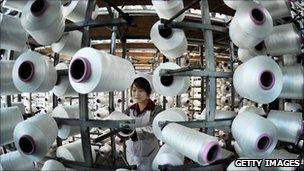World Economic Forum seeks to sustain Asian growth
- Published

Export-dependent economies in Asia-Pacific are facing a challenge to maintain the pace of growth
As some of the biggest and sharpest minds on the global economic stage gather in Jakarta for the World Economic Forum on East Asia, sustainability of growth is likely to be the focus.
More than 500 delegates from business, government and other fields will be coming together in the Indonesian capital from 12 June under the theme of Responding to the New Globalism.
The tremendous growth of Asia-Pacific economies, coupled with a slowdown in the US and Europe, has seen a drastic shift in the global economic power in the past two to three years.
Led by China and India, emerging economies have pulled the world out of the financial crisis and put it back on the growth track.
Such has been their dominance that the sustainability of their growth is now key to global economic expansion.
"There is a good reason why policymakers are so concerned about the imbalance in the global economy," says Kalpana Seethepalli, infrastructure economist at the World Bank.
Analysts say that if emerging economies slow down, especially in the Asia-Pacific region, it will have a huge knock-on effect.
"The growing size and importance of the Chinese economy has increased the vulnerability of other Asia-Pacific countries to a sharp Chinese economic slowdown," says Rajiv Biswas of IHS Global Insight.
"There is no doubt that such a slowdown would hit other Asian economies very hard," he adds.
"Both manufacturing export economies such as South Korea and Taiwan would be hard hit, as well as resource exporters such as Indonesia, Australia and Malaysia," Mr Biswas says.
Interlinked challenges
While the growth of the emerging economies has been fascinating, sustaining the current rate of increase is a tall order for policy-makers.
"Strong growth in most developing economies has contributed to a new set of global challenges," says the World Bank in its June 2011 edition of Global Economic Prospects.
The bank says "higher commodity prices, rising inflation, and the possible return of destabilising capital inflows as monetary policies tighten and interest rates rise" are some of the biggest threats.
For their part, analysts say the biggest headache for policy-makers is that all these problems are interrelated.
"The growth of Asian economies has meant a complete shift in the economic landscape," says Arjuna Mahendran of HSBC Private Bank.
"First, you have people from rural areas migrating to urban centres, that has seen urbanisation reach exponential proportions," he says.
This has resulted in a boom in demand for construction material, driving up commodity prices.
He adds that as ordinary people start benefiting from their countries' new-found success, the problems become still more complex.
"Rising wage pressure in emerging markets is the biggest concern right now," he says.
As people have more disposable income, they tend to spend more, hence driving up demand and pushing up consumer prices, he adds.
Mr Mahendran says governments have to work towards tightening their monetary policy to rein in higher prices.
Capital inflows

Rising prices of food and essential commodities have threatened to derail growth in Asian economies
However, rising interest rates are an even tougher test for policymakers in the region.
As interest rates in developing economies rise, while those in the developed world remain lower, investors are pumping huge amounts of money into the region.
That is driving up property prices and creating potential problems in the medium to long-term future.
"Clearly risks remain of volatile capital flows creating Asian asset bubbles," says Mr Biswas of IHS.
However, the International Monetary Fund (IMF) says that if managed properly, the capital inflows can be turned into an advantage.
"Capital flows to Asia are not only a challenge, but also an opportunity to facilitate medium-term rebalancing," the IMF says in its Regional Economic Outlook for Asia and Pacific.
"The question is how best to channel capital inflows toward financing broader-based growth, and in particular toward boosting investment," the fund adds.
Ms Seethepalli, of the World Bank, explains how this can work.
"The challenge is how to make sure that these inflows are not short-term, but go in to long-term investment," she says.
Ms Seethepalli says that as the public sector funds in most developing economies are already overstretched, governments can use private capital flows to fund and finance infrastructure projects in their countries.
She says that not only will this speed up infrastructure development, a key to maintaining growth in emerging economies, but it will also lower the risk of formation of asset bubbles, as capital is channelled towards the creation of infrastructure assets.
'West to East'
The growth of the Asia-Pacific region has been driven by a boom in its export sector in the past few years.
However, analysts say that the region's economies now have to take advantage of growing demand at home in order to maintain the momentum.
"Asian economies focused on export-led growth," says Ms Seethepalli of the World Bank. "They can't expect any more export stimulus to come from outside, so growth has to be offset by domestic demand."
The IMF says that the region needs to build a solid base going forward.
"Such a platform would depend on reducing inequality; raising employment prospects, which would also guard against risks to social stability; and continued efforts to rebalance growth by strengthening private domestic demand," the fund says.
Analysts say that if the region's economies can achieve the delicate balance between keeping monetary policies tight and maintaining growth, the future belongs to them.
"The shift of economic power from West to East will continue, and Asia-Pacific will remain the most attractive economic region for the next 20 years," says Mr Biswas.